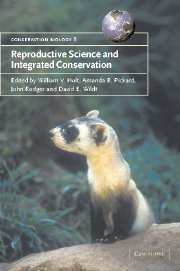Book contents
- Frontmatter
- Contents
- List of contributors
- Foreword
- Part I Introduction
- Part II Reproduction and population viability
- 2 Behaviour and reproduction
- 3 Nutrition and its interaction with reproductive processes
- 4 Environmental chemicals and the threat to male fertility in mammals: evidence and perspective
- 5 Assessing the consequences of inbreeding for population fitness: past challenges and future prospects
- 6 Impacts of inbreeding on components of reproductive success
- 7 The major histocompatibility complex (MHC) in declining populations: an example of adaptive variation
- 8 When is the birth rate the key factor associated with population dynamics?
- Part III Reproductive techniques for conservation management
- Part IV Integrated conservation management
- Part V Reproduction science in non-mammalian species
- Part VI Conclusions
- Index
- References
7 - The major histocompatibility complex (MHC) in declining populations: an example of adaptive variation
Published online by Cambridge University Press: 21 January 2010
- Frontmatter
- Contents
- List of contributors
- Foreword
- Part I Introduction
- Part II Reproduction and population viability
- 2 Behaviour and reproduction
- 3 Nutrition and its interaction with reproductive processes
- 4 Environmental chemicals and the threat to male fertility in mammals: evidence and perspective
- 5 Assessing the consequences of inbreeding for population fitness: past challenges and future prospects
- 6 Impacts of inbreeding on components of reproductive success
- 7 The major histocompatibility complex (MHC) in declining populations: an example of adaptive variation
- 8 When is the birth rate the key factor associated with population dynamics?
- Part III Reproductive techniques for conservation management
- Part IV Integrated conservation management
- Part V Reproduction science in non-mammalian species
- Part VI Conclusions
- Index
- References
Summary
INTRODUCTION AND OBJECTIVES
Conservation biology has focused on the long-term survival of endangered species. To this end, the primary genetic goals in managed populations of endangered species have been the avoidance of lowered fitness from inbreeding and the maintenance of potentially adaptive genetic variation. Captive breeding programmes of endangered species have specifically been designed both to avoid inbreeding (inbreeding depression) and to retain a given amount of genetic variation for a given period of time, primarily by minimising mean kinship in the population (Ballou & Lacy, 1995). Generally these goals are mutually consistent and may also serve other purposes, such as avoiding adaptation to captive conditions, avoiding accumulation of detrimental variants and maintenance of adaptive variation.
However, as more molecular genetic information accumulates, it is useful to consider whether these new data can be used to manage more effectively genetically captive populations. For example, by using a number of microsatellite loci (over 5000 highly variable genes have been described in humans; Dib et al., 1996), it may be possible to estimate the relationships among founders or other individuals of unknown ancestry. With this information, breeding plans may be modified to reflect previously unknown relationships as well as those known from captive breeding. Relevant to the discussion here, it may be possible to determine the value of maintaining particular genetic variants in a population because of their adaptive significance. Priority could be given to breeding individuals or groups of individuals that would maintain these adaptive variants.
- Type
- Chapter
- Information
- Reproductive Science and Integrated Conservation , pp. 97 - 113Publisher: Cambridge University PressPrint publication year: 2002
References
- 2
- Cited by

